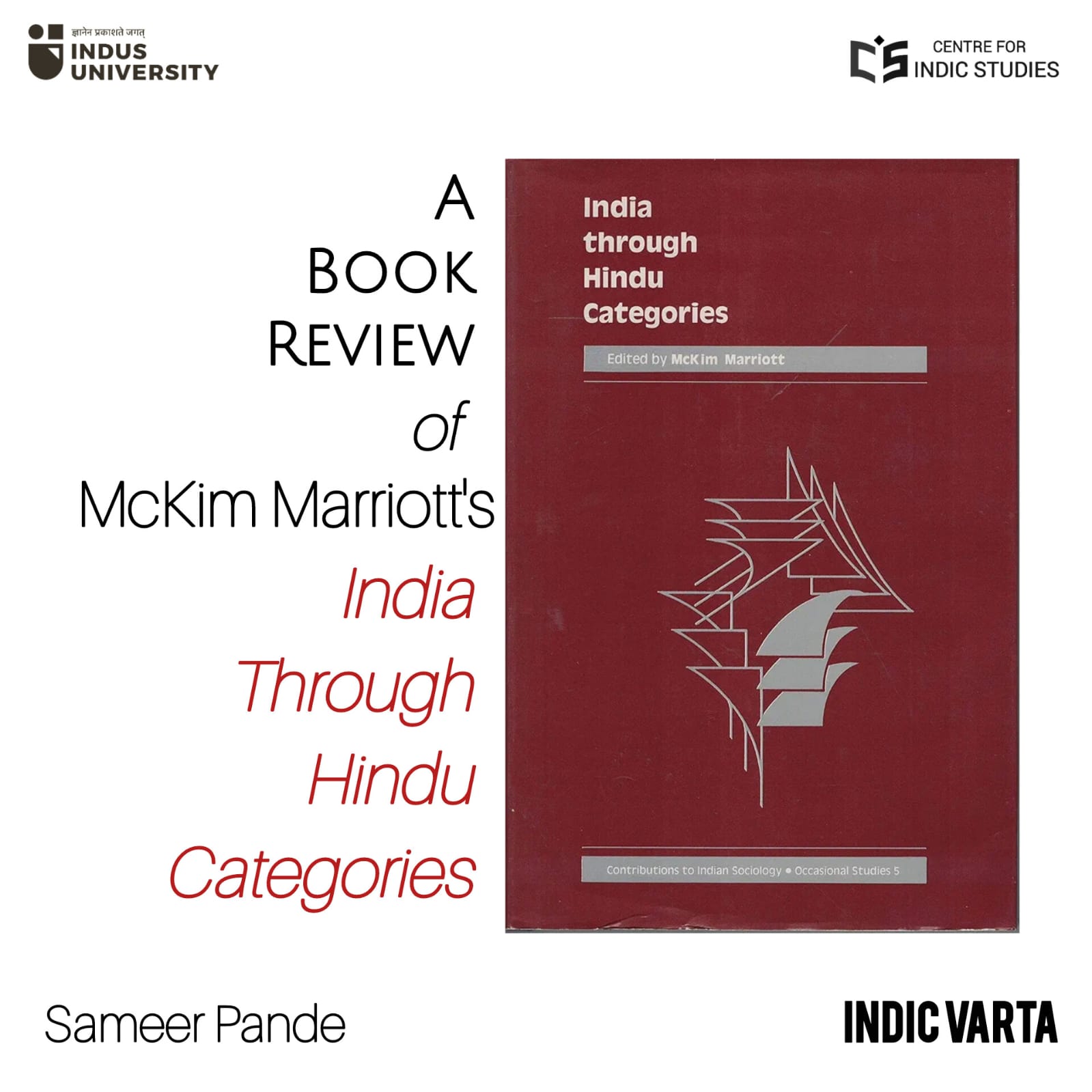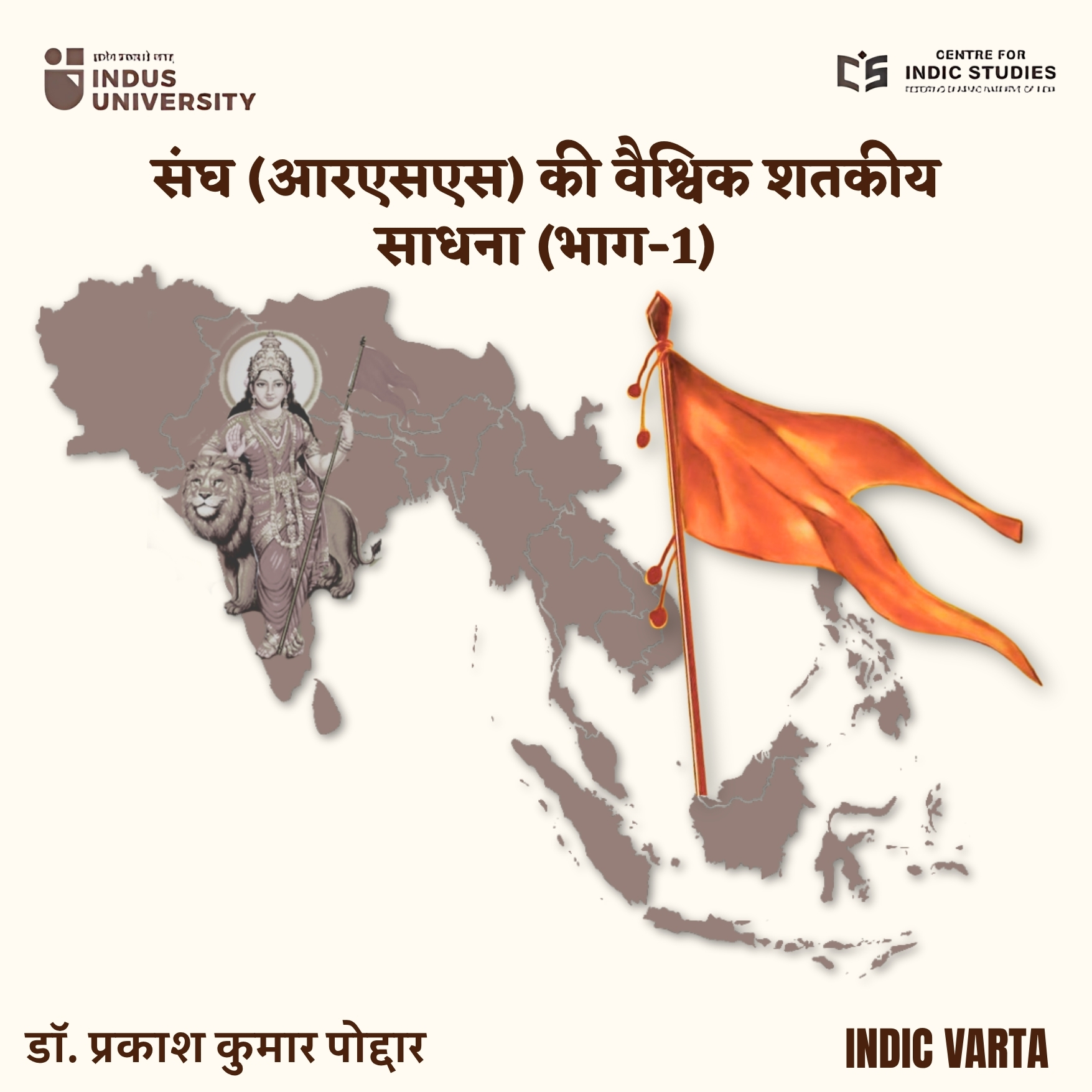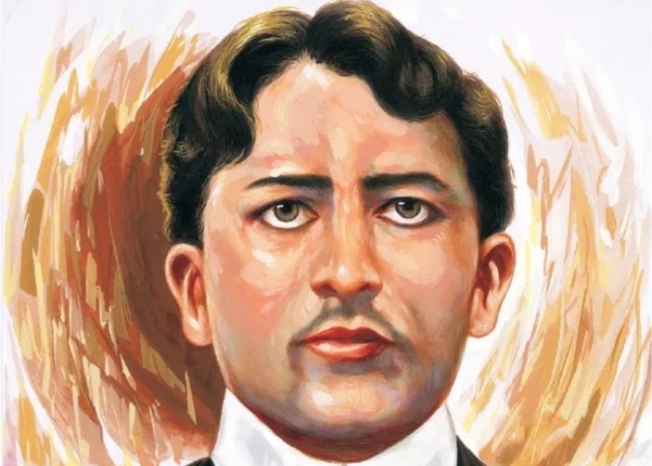- Visitor:62
- Published on: 2025-10-11 04:38 pm
A Book Review of McKim Marriott’s India Through Hindu Categories
Why is it that India is always forced to look at herself in a borrowed mirror? Why must Weber define our bureaucracy, Marx our economy, Dumont our caste, while our own categories, our own vocabulary, remain unused? India Through Hindu Categories, edited by McKim Marriott with a preface by T.N. Madan, published in 1990, is one of those rare books that refuses to play this game. It doesn’t politely add Indian examples to Western theories. Instead, it asks: why not think through India, in her own idioms?

The title of the book itself is unsettling in the best way: Hindu categories. Not South Asian society. Not the Indian social system. Hindu categories. It signals from the start that this is not anthropology on India, but sociology attempted through India. That shift is not cosmetic, it is civilizational.
In his introduction, Marriott explains the background: How Ethno-sociology, cognitive anthropology, and cultural analysis grew in the West, then were imposed on Indian subjects as universal. But the fit was always awkward, wasn’t it? Like trying to measure Ayurveda with a stethoscope. The question he raises is simple yet radical: why not use Hindu cultural categories to understand South Asian social behaviour?
And when I read this, I felt something click. I had always suspected that words like Karma, Dharma, Ritu, Dosha, Shakti, Svabhava were not just religious words but living categories of behaviour. Marriott showed me they could be used analytically. In fact, he suggests that exploring South Asian concepts of person and interpersonal relations might even expand the global behavioural sciences of psychology and sociology. Imagine that: India not as a subject of sociology, but as its teacher.
The contrast he draws is powerful. Western analysis often swings between folklore and karma, cognitive anthropology and old philological Indology, never quite willing to step inside. Louis Dumont’s Homo Hierarchicus (1957) is the best-known example: a model of Indian society built narrowly on purity and pollution. But is Hindu life really reducible to that single axis? Marriott and his colleagues argue no. Life here is multi-layered, many-dimensioned, and cannot be trapped in one frame.
That is why the essays in this book matter. Marriott notes three things about them. First, they diverge from one-dimensional normative analyses and rigid structuralisms. Second, they refuse to assume invariances of units like “caste,” “house,” or “person.” and third, they avoid being tied down to categories like “forces of production” or abstract conceptual free play. Instead, they work from within Hindu life itself: with elements, humours, strands, divergent aims of action—categories taken as axiomatic in South Asian traditions.
Reading this, I found myself smiling. Here was what I had long intuited: Hindu categories are not dead traditions, they are living epistemology. What if sociology itself could be reconstructed using them? What if humoral flows were not superstition but a valid sociology of relations? What if dharmic action was not ritualism but behavioural science?
That is why I call the introduction not a polite preface but a manifesto. It bluntly tells the reader: do not expect Dumont’s India, Weber’s India, Marx’s India. Enter instead the India that reasons through her own vocabulary, the India that can expand the sciences themselves.
The volume then unfolds into eight essays. For me, this book was like being handed a mirror for the first time, not the cracked, borrowed one from the West, but one that reflected India as she sees herself. And once you see that reflection, it becomes hard to go back
Constructing an Indian Ethnosociology – McKim Marriott
This is a must read.
So, here’s the problem Marriott begins with: Indians have always been studied as if they were Europeans in disguise. Western thinkers like Marx, Weber, Durkheim, Lévi-Strauss all gave us categories like “class,” “religion,” “status,” “purity,” “ideology,” “authority.” These categories worked for their societies, but when used for India, they feel like a shirt stitched for someone else. They don’t quite fit our realities.
Marx reduced society to “material base” and “superstructure.” Lévi-Strauss divided life into “nature” and “culture.” Durkheim defined religion in his own French way. Weber spoke of social differentiation in terms of economic class. But is Indian life really organized this way? Do we see our world in such binaries?
Marriott says, no. though he is trying to explain India to Westerners therefore, taking their own terms to them. Indians think in their own categories. We don’t just think in opposites; we think in layers, in flows, in relationships. Our social reality is not built like a flat plane of equals but like a shifting cube, many dimensions, many angles.
Take an example: the West likes binary pairs—rich/poor, pure/impure, high/low. But Indian categories are often non-binary. Think of the “three” (trinity of Brahma-Vishnu-Mahesh, or the three bodily humors—vāta, pitta, kapha). Think of the “four” (the puruṣārthas—dharma, artha, kāma, mokṣa; or the four āśramas). Or think of layered relations, child, parent, ancestor, all linked, never reducible to just one binary opposition.
Marriott even brings in Gloria Raheja’s research in a North Indian village (Pahansu, 1989). She shows that caste relations can be seen through three lenses at once: mutuality (exchange, sharing), hierarchy (ranking), and centrality (who holds the middle). So, there isn’t one model of society but overlapping dimensions.
He calls this the “layered cube.” Imagine every social thing, whether an atom, a family, a festival, or even a feeling, having to be understood along at least three shifting dimensions at once. From one angle, it might look hierarchical; from another, mutual; from another, central. No single category captures it. That’s how Hindu categories actually work: fluid, dynamic, relational.
Western thinking rests on what he calls equivalence logic meaning everything has a fixed definition, rules apply equally to all, like Euclidean geometry or modern law. But Indian thinking works with mixing, marking, and matching. We constantly mix different elements (traditions, foods, rituals), mark distinctions (who is elder, who is guest, who is priest), and match things (aligning festivals, family ties, cosmic rhythms). Our society is not rigid - it is fluid, situational, layered.
Marriott argues this way of thinking is not parochial at all. In fact, it may be more universal than the West realizes. Hindu categories like dravya (substance), dhātu (element), or prakṛti (nature) deal with universal flux and relations, ideas closer to modern mathematics and physics than to fixed Western social models. Think of Ayurveda’s humors or Sāṅkhya’s strands, not superstition, but relational sciences that describe human and cosmic processes.
Of course, there’s a risk. Some may accuse this approach of relativism (Post modernism or post-positivism) “your categories, my categories, who’s right?” But Marriott turns that around. He says Hindu ethnosociology, because of its relational and processual way of thinking, may actually be the least parochial, most universal of all. Instead of forcing everyone into one rigid model, it allows for multiple truths, multiple layers, multiple perspectives.
India does not need to be studied with imported tools. We can build our own social sciences from our own categories, categories that may even enrich world knowledge. The choice is ours: continue to wear borrowed clothes or stitch a sociology in our own fabric.
Is there an Indian Way of Thinking? By A. K. Ramanujan
This is where the whole book suddenly shifts tone. Marriott sets up the field, but Ramanujan takes the stage and throws a deceptively simple question in our face: “Is there an Indian way of thinking?” Now, if it were just the question, it would have been straightforward. But Ramanujan is mischievous, he asks us to look at each word in that sentence. Is? An? Indian? Thinking? Suddenly the question explodes into four directions at once.
And here, as I was reading, I caught myself nodding, because haven’t we all struggled with this? Is there a singular “Indian” way, or are there many? Do we mean Indian as a modern, post-colonial identity? Or do we mean it in the pre-colonial, pre-Newtonian, pre-Christianizing sense where categories were fluid, experience was internal, and the observer was not detached but entangled?
Ramanujan reminds us that before Newton drew his famous lines of universal law, the Indian mode of thought was not about detached objectivity but about internal resonance. The world wasn’t “out there” to be measured; it was “in here,” refracted through the self. And then he pulls out Max Müller’s lectures from 1883- remember, Müller said Hindus had a “truthful character.” That sounds flattering, but Ramanujan places it alongside Hegel’s sly remark from 1827: bravery, for Hindus, is not universal but the dharma of the Kshatriya. Do you see what’s happening? The West keeps searching for universal virtues “bravery is bravery, truth is truth” but the Indian response is always particular: bravery for the warrior, truth for the Brahmin, hospitality for the Gṛhastha. A science of particularism.
Dharma here isn’t moralistic; it’s contextual. Ashramadharma, svadharma, āpaddharma, duty by stage of life, duty by one’s own role, duty even in times of crisis. Every dharma is tied to a situation. And with it comes phalaśruti the outcome or consequence. Meaning, you don’t just act; your action is measured in its appropriateness to its time, place, and role.
Ramanujan then ties this to Naadishastra, where even a person’s pulse is read not just medically but as a narrative of their life, a personalized history. Every story, he says, is encased in a metastory, a larger narrative, like the string that binds palm-leaf manuscripts. This is so typically Indian: meaning doesn’t float abstractly; it is always tied, knotted, context-bound. He even borrows from Peirce’s semiotics (1931–58): these are not arbitrary “symbols” like in the West; they are indexical signs, signifies and signified locked in the same lived world.
And this contextual sensitiveness isn’t just philosophy. It permeates everything: the idea of ṛtu-sāmya appropriateness to season applies to poetry, music, sacrifice, medicine. Even the Bṛhadāraṇyaka Upaniṣad (5.1) offers the triad: Datta, Dayadhvam, Damyata — give, sympathize, control. Again, each is relational, situational.
Think about it: categories like rasa, mokṣa, saṃnyāsa, sphoṭa, bhakti none of them can be reduced to universalist abstractions. They are experiential, embedded in practice. Ramanujan contrasts this with the West: while all societies have context-sensitive rules, Western ideals (Protestant Christianity, democracy, egalitarianism) elevate context-free universals. “All men are equal” - abstract, disembedded. India instead says: “Each man has his dharma.” That’s not hierarchy blindly defended; that’s contextuality defended.
And then Ramanujan delivers his most charming example: the Ayudha Pūjā for computers and typewriters. This isn’t quaint ritualism. It’s a perfect illustration of non-compartmentalization. The machine isn’t “just technology”; it too enters the sacred web of relationships. Tools are not neutral, they are enspirited, honoured, integrated.
So, is there an Indian way of thinking? By the end of the essay, Ramanujan doesn’t give us a single definition. Instead, he shows us that the Indian way itself resists singularity. It is plural, contextual, non-compartmentalized, particularistic, and always tied to lived dharma.
As I read this, I realized something, I always knew this intuitively. When elders in my family spoke of śraddha or insisted that certain foods were “not for this season,” I never thought of it as philosophy. But Ramanujan puts words to it. He shows that our way of thought is not chaotic or “unscientific,” but a coherent civilizational mode, just not universalist, not detachable.
Now, I want to ask you, the reader: isn’t this precisely what we have been missing in modern scholarship? We keep trying to squeeze India into ready-made boxes of universal categories. Ramanujan instead tells us: let the boxes be contextual, let thought be tied to lived life. Maybe that is the Indian way of thinking.
The Original Caste – Power, History and Hierarchy in South Asia by Nicholas Dirks
We have been told for decades that caste in India is nothing but a pyramid of purity and pollution. At the top sit the Brahmins, at the bottom the untouchables, and everyone else is neatly slotted in between, as if the entire civilization can be flattened into a Dumontian flowchart. But let me ask:
Did Indian life really move in such straight lines? Did kings, armies, land, and politics simply bow to ritual priests and their categories? Nicholas Dirks, in his essay The Original Caste: Power, History and Hierarchy in South Asia, tears into this simplistic imagination and insists that caste has always been shaped as much by politics and history as by ritual.
Dirks does not deny that religion matters, but he reminds us that kingship, land grants, armies, and local authority mattered just as much. For instance, a king’s role is tricky: was he inside caste or outside caste? Sometimes he was a Kshatriya upholding dharma, but sometimes he stood above the system altogether, bending Brahmins and commoners alike to his will. A king gave land to priests, yes, but in return priests blessed his authority. Who was superior then, the giver or the receiver? The point is: caste was never a frozen pyramid, it was a living, negotiating battlefield where ritual and political powers fed off each other.
This is where Dirks scores his strongest point: caste cannot be understood through a single formula. Louis Dumont (in Homo Hierarchicus, 1957) reduced caste to ritual hierarchy of purity/pollution. Dirks shows how misleading this is. In real villages, in small “little kingdoms,” hierarchies shifted. A warrior clan that defeated rivals could suddenly rise in rank; a Brahmin group without royal patronage could lose its sheen. In some cases, kings commanded Brahmins; in others, Brahmins legitimized kings. There is no single, eternal order, there are shifting, historically situated hierarchies.
Here, we again should not fall into the discussion of circulation of power theory by Vilfredo Pareto. (We will discuss this in another article.)
Take the “local” versus “pan-Indian” picture. In textbooks, caste looks like a clean chart. In real life, each region had its own flavor. In Tamil polities, land rights shaped caste; in North Indian villages like Pahansu, studied by Gloria Raheja, centrality, mutuality, and hierarchy constantly overlapped. Dirks’ contribution is to show how such variations are not exceptions, they are the norm. Caste was not only about ritual ideas but also about material resources, political power, and historical change.
And what about the claim that caste is timeless? Dirks shows the opposite. History mattered. Conquests, migrations, agrarian expansion, colonial interventions, all reshaped who stood where. Caste was never just a religious structure; it was a dynamic process, entangled with kingship, economy, and politics.
So, what do we learn from Dirks? That the so-called original caste is neither purely religious nor purely political but a fusion of both. That the categories of Western anthropology - ritual, ideology, structure - are too narrow to explain South Asia’s lived realities. And most importantly, that no single model, be it Dumont’s purity/pollution or Marx’s material base, can capture the fluidity of Indian society.
I must admit, when I first encountered caste theories, I was stunned, this was not what I had learnt in my gurukul times and not in the original texts which I studied. But, in the graduation period we were fed only the Dumontian diet: purity here, pollution there and unfortunately, even our own Indian born start believing this, which is a real cry! But reading Dirks opened the cracks in that neat diagram, at least coming from western will not bring back Indian heads to senses. Caste was not only about who touched whom, but also about who owned the fields, who commanded the armies, and who received land grants from kings. Ritual without politics is a dead body; politics without ritual legitimacy is a body without soul. Together, they make the living organism we call caste.
Dirks, therefore, liberates westernized minds from seeing caste as a mere frozen hierarchy. He shows us a system that is historical, political, negotiated, and ever-changing. And that, perhaps, is the most Indian thing about caste: its refusal to be trapped in one rigid definition.
Centrality, Mutuality and Hierarchy – Shifting Aspects of Inter-Caste Relationships in North India by Gloria Goodwin Raheja
When Western sociology looks at India, it almost always draws a pyramid. Brahmins at the top, “untouchables” at the bottom, and everyone neatly stacked in between. But is that really how Indian villages live? so, we must visit villages first, not with western mindset, not as a political analyst, but as a seeker, as a learner. Gloria Raheja, through her ethnographic work in the Pahansu village of western Uttar Pradesh, forces us to pause and rethink. Her fieldwork is not done from a distance, not reduced to a model already fixed in Paris or London, but from the ground, listening to songs, recording rituals, tracing exchanges, and sitting with the villagers themselves. And what does she discover? That hierarchy is only one part of the story.
Raheja shows that inter-caste relations are shaped not only by hierarchy, but also by mutuality (reciprocity, exchange, interdependence) and centrality (closeness to shared rituals, festivals, and cultural centre). These are not abstract concepts; she saw them in practice. For example, when one caste gives ritual gifts to another, or when a lower caste community plays indispensable roles in weddings and festivals, the relation is not merely “higher–lower.” It is also one of reciprocity: “I need you; you need me.” Similarly, centrality comes alive in the way certain households, temples, or ritual centres draw in all communities, making status less about vertical rank and more about proximity to sacred or social centres.
Think about this: in Dumont’s model (Homo Hierarchicus), purity and pollution decide everything. But Raheja’s data shows that songs sung by women during marriage ceremonies or rituals of gift-giving create networks of obligation that cannot be reduced to purity alone. A so-called “lower” caste may, through these exchanges, command respect and indispensability that Dumont’s model would never predict.
Her method is as important as her conclusions. She doesn’t walk into the village with survey sheets asking: “Who is higher? Who is lower?” Instead, she listens to cultural expressions—songs, narratives, ritual practices. She asks not “What is your caste rank?” but “Tell me the story of this festival,” or “What happens when a girl is married here?” The data emerges from lived voices, not imposed categories. For researchers stuck in the Western style of extracting rigid answers, this is a revelation: you don’t always need a checklist; sometimes you need to let the village sing to you.
And this is where Raheja turns the game. By adding mutuality and centrality to hierarchy, she shows that caste is not a single, one-dimensional axis but a three-dimensional system, fluid and shifting. In one situation, ritual hierarchy dominates; in another, reciprocity takes centre stage; in yet another, centrality matters most. It’s not that Dumont is completely wrong, it’s that he is painfully incomplete.
What strikes me is how close this feels to our own traditional categories. Isn’t this what dharmic thought has always said? That society is held together not by a single axis but by a web, of obligations, duties, flows, and central nodes? Raheja, though writing as an anthropologist, almost rediscovers this Indian wisdom by listening closely.
For me, the lesson was double. First, for scholars: never reduce Indian life to a model made elsewhere, listen to the voices within. Second, for readers: Caste is not a static pyramid but a shifting dance, where hierarchy, mutuality, and centrality weave together. If Dumont gave us a line, Raheja gives us a cube.
[This is the first part one of the book review. In the next part we will discuss the other ways to understand more about Indic Categories in Social sciences.]
- 31 min read
- -1
- 0










